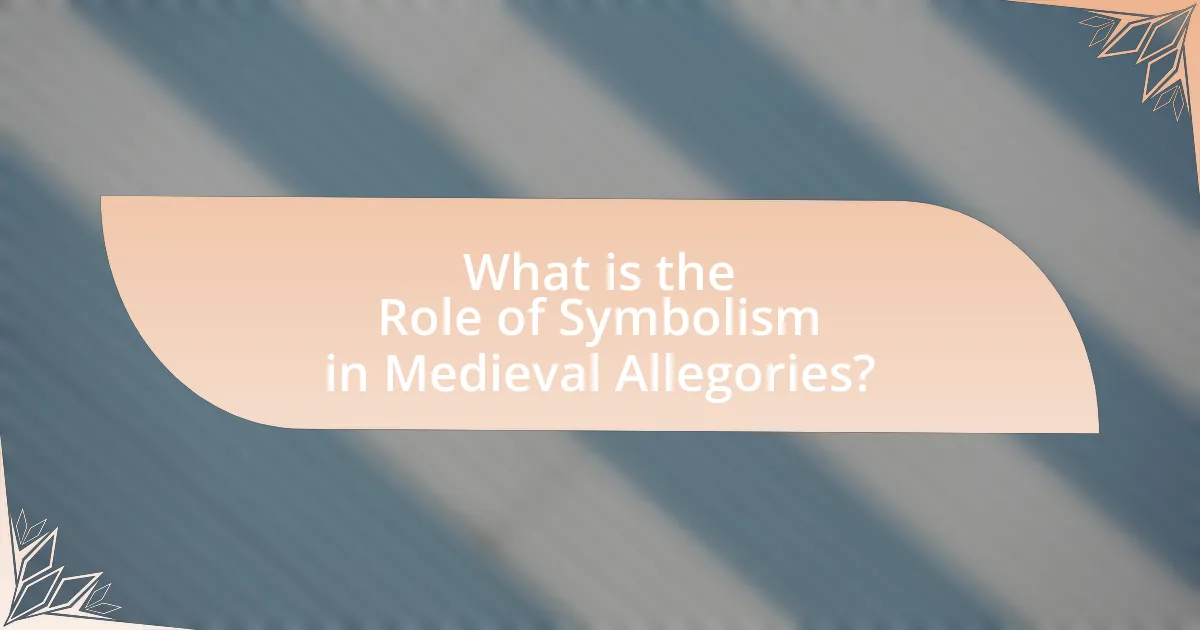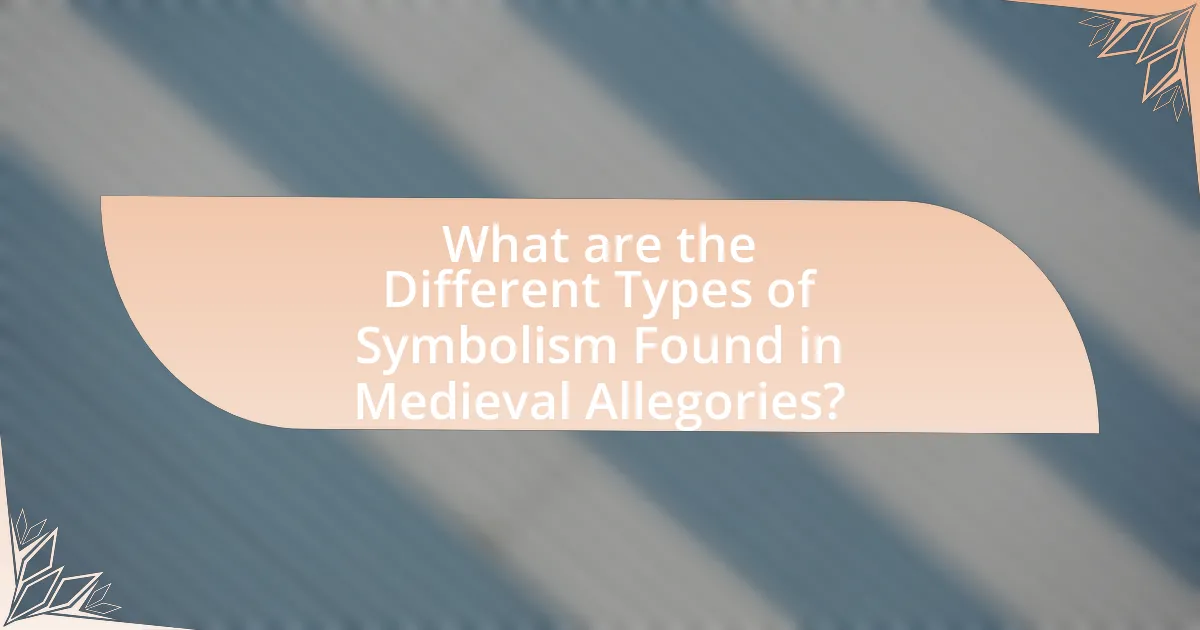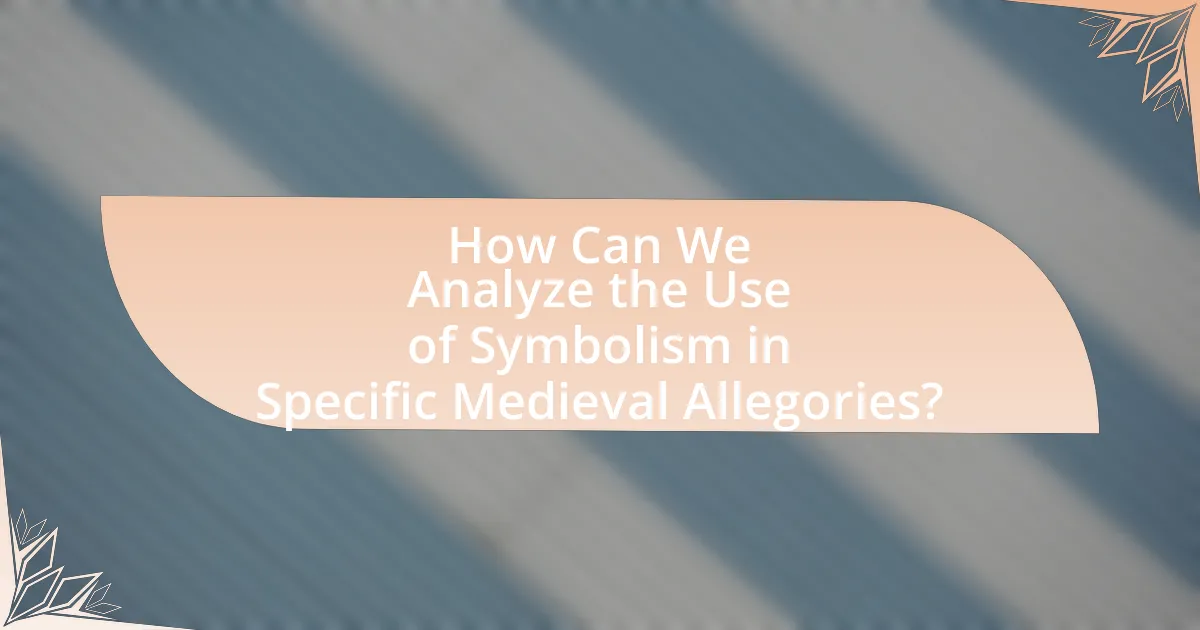The article examines the role of symbolism in medieval allegories, highlighting its significance in conveying complex moral, spiritual, and philosophical ideas through representative figures and imagery. It discusses how symbolism enhances narratives by providing deeper layers of meaning, with examples from notable works such as Dante Alighieri’s “The Divine Comedy” and William Langland’s “Piers Plowman.” Key symbols, including animals and natural elements, are analyzed for their representation of virtues, vices, and societal critiques, while the cultural and historical context that influenced these symbols is also explored. The article emphasizes the importance of understanding these symbols to grasp the moral lessons embedded within medieval allegorical literature.

What is the Role of Symbolism in Medieval Allegories?
Symbolism in medieval allegories serves to convey complex moral, spiritual, and philosophical ideas through representative figures and imagery. This technique allows authors to communicate deeper meanings and societal critiques while engaging the audience’s imagination. For instance, in works like “The Divine Comedy” by Dante Alighieri, characters and settings symbolize various virtues and vices, illustrating the journey of the soul towards God. Such allegorical representations enable readers to interpret the text on multiple levels, enriching their understanding of the moral lessons embedded within the narrative.
How did symbolism enhance the narrative in medieval allegories?
Symbolism enhanced the narrative in medieval allegories by providing deeper layers of meaning that conveyed moral and spiritual lessons. Allegorical figures, such as Lady Justice or the Seven Deadly Sins, represented abstract concepts, allowing readers to engage with complex ideas in a relatable manner. For instance, in “The Divine Comedy” by Dante Alighieri, the journey through Hell, Purgatory, and Heaven symbolizes the soul’s path toward God, illustrating the consequences of sin and the importance of redemption. This use of symbolism not only enriched the narrative but also facilitated the transmission of ethical teachings, making the allegories more impactful and memorable for the audience.
What are the key symbols commonly used in medieval allegories?
Key symbols commonly used in medieval allegories include the rose, representing divine love and beauty; the lion, symbolizing strength and courage; and the journey, which signifies the soul’s path toward salvation. These symbols are prevalent in works such as Dante’s “Divine Comedy,” where the journey reflects the spiritual quest, and in various chivalric romances where the lion embodies noble qualities. The consistent use of these symbols across different texts reinforces their significance in conveying moral and spiritual lessons central to medieval thought.
How do these symbols relate to the themes of the allegories?
Symbols in medieval allegories serve to illustrate and reinforce the central themes of morality, virtue, and the human condition. For instance, in “The Divine Comedy” by Dante Alighieri, the journey through Hell, Purgatory, and Heaven symbolizes the soul’s path towards redemption, reflecting the theme of divine justice and the consequences of sin. Similarly, in “Piers Plowman” by William Langland, the character of Piers represents Christ-like qualities, emphasizing the theme of social justice and the importance of living a virtuous life. These symbols are not merely decorative; they are integral to conveying the deeper moral lessons and philosophical inquiries that define the allegorical narratives.
Why was symbolism important to medieval audiences?
Symbolism was important to medieval audiences because it served as a means of conveying complex ideas and moral lessons in a visually accessible manner. In a time when literacy rates were low, symbols allowed for the communication of religious and ethical concepts through art, literature, and architecture. For instance, the use of the cross in Christian iconography represented salvation and sacrifice, making profound theological ideas understandable to the general populace. Additionally, allegorical works like Dante’s “Divine Comedy” utilized symbolism to explore themes of sin, redemption, and divine justice, engaging audiences on multiple levels and fostering a deeper understanding of their faith and societal values.
How did symbolism aid in the understanding of moral lessons?
Symbolism significantly aided in the understanding of moral lessons by providing a visual and conceptual representation of complex ideas. In medieval allegories, symbols such as the journey, light, and darkness were employed to convey moral truths, making abstract concepts more accessible to the audience. For instance, in Dante Alighieri’s “Divine Comedy,” the journey through Hell, Purgatory, and Heaven symbolizes the soul’s path toward redemption, illustrating the moral lesson of the consequences of one’s choices. This use of symbolism allowed audiences to grasp intricate moral teachings through relatable imagery and narratives, enhancing their comprehension and retention of these lessons.
What cultural factors influenced the use of symbolism in this period?
Cultural factors that influenced the use of symbolism in the medieval period include the dominance of Christianity, the feudal system, and the rise of vernacular literature. The Christian Church played a pivotal role in shaping symbolism, as religious themes and moral lessons were often conveyed through allegorical representations, such as the use of light to symbolize divine truth. The feudal system created a hierarchical society where symbols represented social status and power dynamics, evident in the use of heraldry and coats of arms. Additionally, the emergence of vernacular literature allowed for more localized and relatable symbols, reflecting the everyday lives and beliefs of the common people, as seen in works like Dante’s “Divine Comedy.” These cultural elements collectively fostered a rich tapestry of symbolism that permeated medieval allegories.

What are the Different Types of Symbolism Found in Medieval Allegories?
Different types of symbolism found in medieval allegories include moral, religious, and political symbolism. Moral symbolism often represents virtues and vices, illustrating ethical lessons through characters and events, as seen in works like “Everyman.” Religious symbolism conveys spiritual truths and biblical narratives, exemplified in Dante Alighieri’s “Divine Comedy,” where characters symbolize various theological concepts. Political symbolism reflects social and political commentary, often critiquing contemporary governance, as demonstrated in Chaucer’s “The Canterbury Tales,” where characters embody different societal roles and issues. These types of symbolism serve to deepen the narrative and convey complex ideas in a manner accessible to the audience of the time.
How do religious symbols manifest in medieval allegories?
Religious symbols manifest in medieval allegories primarily through the representation of moral and spiritual truths. For instance, the use of the cross in allegorical literature often symbolizes sacrifice and redemption, reflecting Christian beliefs central to medieval society. Additionally, characters in works like Dante’s “Divine Comedy” embody virtues and vices, with their journeys illustrating theological concepts such as sin, grace, and salvation. This allegorical framework allows for a deeper exploration of faith, as seen in the personification of virtues like Charity and Hope, which serve to instruct readers on moral conduct aligned with religious teachings.
What specific religious figures or concepts are commonly symbolized?
Commonly symbolized religious figures include Jesus Christ, the Virgin Mary, and saints such as St. Peter and St. Paul. Concepts like salvation, sin, and divine grace are also frequently represented. For instance, Jesus is often symbolized by the lamb, representing sacrifice and innocence, while the Virgin Mary is depicted with symbols like the rose, signifying purity. Historical texts, such as Dante Alighieri’s “Divine Comedy,” illustrate these symbols in the context of medieval allegories, reinforcing their significance in conveying complex theological ideas.
How do these religious symbols contribute to the overall message?
Religious symbols in medieval allegories enhance the overall message by providing deeper layers of meaning and moral guidance. These symbols, such as the cross representing sacrifice or the lamb symbolizing innocence, serve to connect the narrative to spiritual themes and ethical lessons. For instance, the use of the cross not only signifies Christ’s sacrifice but also emphasizes themes of redemption and hope, reinforcing the allegorical message of salvation. This integration of symbols allows the audience to engage with complex ideas in a more relatable manner, facilitating a richer understanding of the text’s moral and spiritual implications.
What role do natural symbols play in medieval allegories?
Natural symbols in medieval allegories serve as essential tools for conveying complex moral and philosophical ideas. These symbols, such as animals, plants, and celestial bodies, represent abstract concepts like virtue, sin, and divine order, allowing authors to communicate deeper meanings through relatable imagery. For instance, in “The Divine Comedy” by Dante Alighieri, the use of the leopard, lion, and she-wolf symbolizes different sins and obstacles on the path to salvation, illustrating the moral journey of the protagonist. This method of employing natural symbols not only enriches the narrative but also engages the audience in interpreting the allegorical layers, making the moral lessons more accessible and impactful.
How are animals and plants used symbolically in these narratives?
Animals and plants in medieval allegories are used symbolically to represent human traits, moral lessons, and societal values. For instance, animals often embody specific characteristics; a lion may symbolize courage and nobility, while a fox represents cunning and deceit. Similarly, plants can signify various concepts; for example, the rose often symbolizes love and beauty, while thorns may represent pain or sacrifice. These symbolic representations serve to convey complex ideas and moral teachings in a relatable manner, allowing audiences to engage with the narratives on a deeper level. The use of such symbolism is evident in works like “The Pearl” and “The Divine Comedy,” where animals and plants are integral to the allegorical messages being communicated.
What do these natural symbols reveal about human nature?
Natural symbols in medieval allegories reveal fundamental aspects of human nature, such as the connection between humanity and the natural world, the struggle between good and evil, and the quest for moral understanding. For instance, the use of the rose often symbolizes love and purity, reflecting the human desire for connection and beauty. Similarly, the depiction of animals, like the lion representing courage or the fox symbolizing cunning, illustrates inherent human traits and moral lessons. These symbols serve as a mirror to human emotions and ethical dilemmas, emphasizing the complexity of human behavior and the universal themes of morality and virtue present in medieval literature.

How Can We Analyze the Use of Symbolism in Specific Medieval Allegories?
To analyze the use of symbolism in specific medieval allegories, one must first identify the symbols employed within the texts and their corresponding meanings. For instance, in “The Divine Comedy” by Dante Alighieri, the journey through Hell, Purgatory, and Heaven symbolizes the soul’s path toward God, reflecting medieval Christian beliefs about sin and redemption. Analyzing these symbols involves examining their historical context, literary function, and the moral or philosophical messages they convey. Scholarly interpretations, such as those found in “Allegory and the Classical Tradition” by John M. McManamon, provide insights into how these symbols were understood in their time, reinforcing the significance of allegorical representation in medieval literature.
What are some notable examples of medieval allegories rich in symbolism?
Notable examples of medieval allegories rich in symbolism include “The Divine Comedy” by Dante Alighieri, “Piers Plowman” by William Langland, and “The Pearl” by an anonymous poet. “The Divine Comedy” uses the journey through Hell, Purgatory, and Heaven to symbolize the soul’s path to God, with characters representing various moral and philosophical concepts. “Piers Plowman” employs dream visions to explore social justice and spiritual truth, with allegorical figures like Lady Holy Church and Piers symbolizing the ideal Christian life. “The Pearl” features a father’s grief and the symbolism of the pearl as a representation of divine grace and the afterlife. These works exemplify the rich use of allegory and symbolism in medieval literature, reflecting the era’s theological and moral concerns.
How does “The Divine Comedy” utilize symbolism throughout its narrative?
“The Divine Comedy” utilizes symbolism extensively to convey complex themes and moral lessons throughout its narrative. The journey through Hell, Purgatory, and Heaven represents the soul’s path toward God, with each realm symbolizing different states of sin, purification, and salvation. For instance, the three beasts encountered by Dante— the leopard, lion, and she-wolf— symbolize different types of sin: lust, pride, and avarice, respectively. Additionally, the use of numbers, particularly the number three, reinforces the theme of the Holy Trinity, as seen in the structure of the poem divided into three parts, each containing 33 cantos, plus one introductory canto. This numerical symbolism emphasizes the divine order and the journey toward spiritual enlightenment. The vivid imagery and allegorical figures, such as Virgil representing human reason and Beatrice symbolizing divine love, further illustrate the moral and philosophical underpinnings of the narrative, making the symbolism integral to understanding the text’s deeper meanings.
What symbolic elements are present in “Piers Plowman” and their significance?
“Piers Plowman” contains several symbolic elements, including the character of Piers himself, the Dreamer, and the allegorical figures representing virtues and vices. Piers symbolizes Christ and the ideal of a just society, emphasizing the importance of labor and community in achieving spiritual salvation. The Dreamer represents the human soul’s quest for truth and understanding, navigating through various allegorical landscapes that depict moral and spiritual challenges. Additionally, figures like Lady Holy Church and Lady Wealth illustrate the tension between spiritual and material pursuits, highlighting the significance of prioritizing faith over worldly desires. These symbols collectively convey the poem’s central themes of social justice, spiritual awakening, and the moral responsibilities of individuals within society.
What methods can be used to interpret symbolism in medieval allegories?
To interpret symbolism in medieval allegories, one can employ methods such as historical contextual analysis, literary criticism, and iconographic analysis. Historical contextual analysis involves examining the socio-political and religious background of the medieval period to understand the significance of symbols within their specific time frame. Literary criticism focuses on the narrative structure and character development to uncover deeper meanings behind allegorical representations. Iconographic analysis entails studying visual symbols and their meanings in art and literature, which can reveal layers of interpretation in allegorical works. These methods are validated by the extensive scholarship on medieval literature, such as the works of C.S. Lewis and Northrop Frye, who emphasize the importance of context and symbolism in understanding allegorical texts.
How can historical context enhance our understanding of these symbols?
Historical context enhances our understanding of symbols in medieval allegories by providing insight into the cultural, social, and political circumstances that shaped their meanings. For instance, symbols such as the lion often represented nobility and courage during the feudal system, reflecting the hierarchical structure of medieval society. Additionally, understanding the religious context, such as the significance of the cross in Christian allegories, reveals how these symbols conveyed moral lessons and societal values of the time. Historical events, like the Crusades, also influenced the interpretation of symbols, as they were often used to comment on contemporary issues, thus deepening our comprehension of their layered meanings.
What analytical frameworks are effective for studying symbolism in literature?
Effective analytical frameworks for studying symbolism in literature include structuralism, psychoanalytic theory, and semiotics. Structuralism focuses on the underlying structures that shape meaning, allowing for the analysis of symbols within the context of their relationships to one another. Psychoanalytic theory, rooted in the works of Freud and Jung, examines how symbols reflect unconscious desires and archetypes, providing insight into character motivations and themes. Semiotics, the study of signs and symbols, enables a detailed exploration of how meaning is constructed and conveyed through symbols in texts. Each framework offers distinct methodologies for interpreting the layers of meaning in literary symbolism, particularly in the context of medieval allegories, where symbols often carry multiple interpretations and cultural significance.
What practical approaches can be taken to appreciate symbolism in medieval allegories?
To appreciate symbolism in medieval allegories, one practical approach is to analyze the historical and cultural context in which these works were created. Understanding the societal norms, religious beliefs, and political landscapes of the medieval period can illuminate the intended meanings behind symbols. For instance, many allegories were influenced by Christian theology, where characters and events often represented moral lessons or spiritual truths.
Additionally, engaging with primary texts alongside scholarly interpretations can enhance comprehension. Scholars like C.S. Lewis in “The Allegory of Love” provide insights into the symbolic structures of medieval literature, helping readers decode complex allegorical meanings.
Lastly, participating in discussions or study groups focused on medieval literature can foster diverse interpretations and deepen appreciation for the multifaceted symbolism present in these allegories.